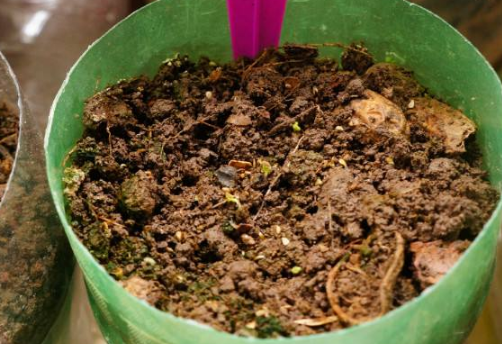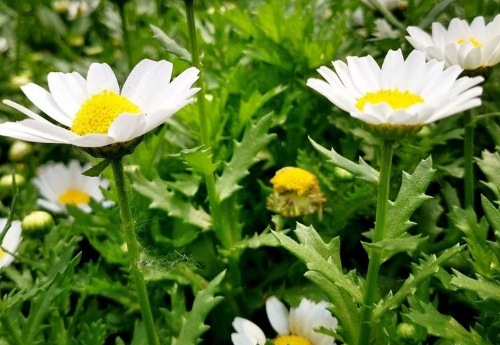Planting methods of Daisy Seeds
1. Treatment of seeds
Soak the seeds of daisies for one night before sowing, so that the seeds can fully absorb water and promote germination.

two。 Raising seedlings in basin soil
It is best to cultivate seedlings in a seedling basin before transplanting. There is not much demand for soil, just keep it warm and moist.
3. Sowing seeds
Generally choose to sow in August-September, before sowing, the soil should be moist first, sowing should be as uniform as possible, there is enough room for growth to increase the survival rate. After sowing the seeds, cover with a thin layer of soil and spray some water.
How to plant daisies? sowing methods of daisies
Daisies, also known as spring chrysanthemum, Malan head flower, longevity chrysanthemum, etc., originated in Europe, and the original species are regarded as tufted weeds. They bloom in spring and are now cultivated all over the world. Garden cultivation in various parts of our country is used as ornamental plants in flower beds. It can be branched and propagated in cold areas that can spend the summer. Let's take a look at how to plant daisies seeds.
Sowing time
Daisies like cool climate, avoid heat, like light, and tolerate semi-shade. The optimum temperature for seed germination is 22-28 ℃, and the suitable temperature for growth is 20-25 ℃. The seeds are very small, with 4900 to 6600 seeds per gram, and most of them are sown in September, while in Zhejiang, they generally begin to sow in late July, mainly from late July to mid-August, when sowing New Year's Day is the heyday.
Sowing method
Daisy sowing selection of loose, breathable medium, the medium after disinfection, it is best to cover with vermiculite, a thin layer, with no seeds for the degree. Because the daisy seed is very small, it is not suitable for sowing, so it is generally used for sowing. When the seedling has 2 or 3 true leaves, it can be transplanted once. The suitable pH value of sowing medium is 5.8-6.5, the EC value is 0.5-0.75, the temperature is 18-20 ℃ after sowing, the humidity is 80-90%, and germination is 5-8 days.
Post-broadcast management
1. The first stage: maintain a temperature of 1822 ℃ and a humidity of 8090% after sowing. The radicle grows on the 5th and 8th day. After germination, it is still necessary to keep the medium moist, do not need to spray fertilizer, need to give light, but the germination time can not be too strong, still need proper shade. From July to August, it is still necessary to cool down by shading around noon.
2. The second stage: in this stage, the humidity is 70-80%, which can make the root penetrate into the medium to absorb nutrients for the extension of its cotyledons, and the temperature is controlled at 16-20 ℃ until the first pair of real leaves unfold. Fertilization can be started, mainly with 20-10-20 water-soluble fertilizer of 50ppm. After this stage, you can start a transplantation with a 288-or 128-point plate.
3. The third stage: this stage is the rapid growth period of seedlings, in order to prevent the medium from getting too wet, 20-10-20 and 14-0-14 special fertilizers of 50ppm are applied alternately. Because of the temperature and transpiration, liquid fertilizer is usually irrigated once every two or three days instead of watering, which is a more scientific method of water and fertilizer management in seedling production. According to the traditional method, if the fertilizer is irrigated at intervals, the concentration will be relatively increased to 70~100ppm. However, the medium should be slightly dried between watering or fertilizer, and alternating between dry and wet should be used to promote the growth of seedlings and the development of roots. When the seedling has 2-3 pairs of true leaves, the height of the seedling is 3-100 cm, and the root system is basically fully developed, the next stage of seedling refining can be carried out.
4. The fourth stage: at this stage, the root system of the seedling has grown well, and there are 3 pairs of true leaves. The seedling refining process before putting on the pot can be considered. The temperature is the same as the previous stage, and the humidity decreases slightly. Moisture control is particularly important at this stage. Apply 14014 water-soluble fertilizer, otherwise the seedlings are easy to grow. Therefore, it is necessary to have enough sunshine, strengthen ventilation, control temperature and humidity, and prevent it from overgrowing.
How to plant daisy seeds
Daisies are perennial herbs belonging to the Compositae family, which are hardy and often cultivated biennial. Some flower friends want to plant daisies, but they suffer from not knowing how to plant daisies. In fact, it is not so difficult to plant daisies.
Daisy seed planting is mainly carried out from August to September every year (this time is relatively best, because some flower friends have successfully sowed in October and May), and blossom 12-14 weeks after sowing. A loose and breathable medium should be selected for sowing. It is best to cover it with vermiculite (other media can also be covered), a thin layer, with no seeds for the degree.
Because the daisy seed is very small, it is not suitable to sow on demand, so it is generally used for sowing, and when the seedling has 2-3 true leaves, it can be transplanted once. Keep the temperature of 18-20 ℃ and humidity of 80-90% after sowing and germinate for 5-8 days. It can also be sowed in spring in Jiangsu and Zhejiang, but the growth and flowering of seedlings are not as good as those sown in autumn. So there is usually no spring sowing.
Daily maintenance of daisies:
Light regulation: daisies also like sunlight, including during the growing and flowering periods. Sufficient light can promote plant growth, green leaves and increase the number of flowers.
Temperature control: after the pot is moved to the protected area to survive the winter, it can prevent the potted flowers from freezing injury in winter.
The above can survive the winter safely, and keeping the temperature of 18-22 ℃ is the most suitable for the formation of good plants. In practice, it is very difficult to do so. Daisies can bloom normally at 10-25 ℃. When the temperature is lower than 10 ℃, the growth is relatively slow, the plant shape decreases, and the flowering is delayed. If the temperature is higher than 25 ℃, the flower stem will elongate, and the growth potential and flowering will decline. From May to June, the temperature rises, and the growth potential and flowering are not ideal, so autumn seedlings are generally used to avoid the rising temperature environment after May.
Water and fertilizer management: daisies like fertile soil, and the base fertilizer in its medium alone can not meet its growth needs. Therefore, when topdressing fertilizer every 7-10 days, 20-10-20 and 14-0-14 flower fertilizer can be used, or compound fertilizer can be applied or irrigated in water with a concentration of 200-250ppm. But the effect of compound fertilizer application is not as fast as that of irrigation. Therefore, if possible, 20-10-20 and 14-0-14 water-soluble flower fertilizers can be used alternately. However, the amount of fertilizer used should be reduced by 20-10-20 in winter, and the medium should be slightly dry, moist but not moist before watering fertilizer. Because of its clustered basal leaves, if not ventilated, the basal leaves are easy to rot and infect bacteria. Sufficient water and fertilizer are given in the growing season to grow luxuriantly and prolong the flowering period.
Cultivation and management: daisies are more resistant to transplantation, and transplantation can make them have multiple roots. There is no need for plant shape pruning and topping to control flowering.
Diseases and insect pests: the main diseases of daisies are seedling quenching, gray mildew, brown spot, anthracnose, downy mildew (chlorothalonil can be used for prevention and control of 800murin and Jiaxianling 1000-1500 times), and insect pests include aphids.
- Prev

Propagation methods of daisies
1. Seed propagation is generally sown from August to September in the south and mostly in spring in the north. Generally, the seeds are sown evenly, covered with fine soil, then watered thoroughly and kept at a temperature of about 28 ℃. New buds can germinate in about 10 days. two。 Ramet propagation can usually dig up the old stubble chrysanthemum cauliflower in the middle and late March.
- Next

Planting conditions of Pinellia ternata
Planting conditions of Pinellia ternata
Related
- Fuxing push coffee new agricultural production and marketing class: lack of small-scale processing plants
- Jujube rice field leisure farm deep ploughing Yilan for five years to create a space for organic food and play
- Nongyu Farm-A trial of organic papaya for brave women with advanced technology
- Four points for attention in the prevention and control of diseases and insect pests of edible fungi
- How to add nutrient solution to Edible Fungi
- Is there any good way to control edible fungus mites?
- Open Inoculation Technology of Edible Fungi
- Is there any clever way to use fertilizer for edible fungus in winter?
- What agents are used to kill the pathogens of edible fungi in the mushroom shed?
- Rapid drying of Edible Fungi

